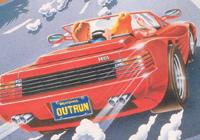3D Out Run (Nintendo 3DS) Second Opinion Review
By Rudy Lavaux  30.04.2015
30.04.2015

Here it is, at last. The great classic a lot of people have been dying to get their hands on. Out Run is perhaps one of the most iconic SEGA arcade classics. From the luxurious sit-down arcade machine, a staple of the 1980's SEGA, to the excellent soundtrack, the eponymous Ferrari Testarossa (a fairly new object of desire back in 1986), and rounding things with fast paced, outstanding graphics for the time, it's easy to see why the game was beloved so much. It would be unwise to classify it as a racing-game since the only thing the player was racing against was the clock and Yu Suzuki, designer of the game, labelled it himself as a driving game. With a strong theme being travelling the world for the beautiful sights it has to offer, with the beautiful blonde in the co-driver's seat, it was, in a sense, a continuation of the Hang-On formula, also by the same designer and company, except with a much different vibe to it. Out Run simply was a masterpiece in its time and, today, the remaining arcade cabinets are seen as symbols of SEGA's past arcade glory. Cubed3 already reviewed this new stereoscopic 3D revival but will now take a different look at it in the form of this C3-2-1 as Cubed3 gives 2 reviews to 1 great game.
This game's obvious predecessor, Yu Suzuki's Hang-On, was SEGA's original take on racing using its now famous Super Scaler technology, which allowed the company to create illusions of 3D by scaling objects zooming towards the camera in fast paced games. Out Run is a logical continuation of this, and although it did not use the exact same hardware but rather an evolution thereof, Out Run shares several elements with its brethren. The zooming scenery with elements on the side of the road, like trees, billboards and lamp posts, moving obstacles on the road that must be avoided, and a fast-paced race against the clock to reach the end of the game, are some key examples. All of these elements are identical to what would be expected from Hang-On, except that there are no other racers on the road, but simply regular vehicles minding their own business, although their leisurely paced driving and the space they take on the road comes as an obstruction when racing against the clock, as Jeremy Clarkson would say they always tend to do. Where Out Run brings its share of originality is in the fact that the road branches out in two at the end of each section, leaving the player with the choice of where the next stage will be set. Additionally, the stages to the left are usually easier than those to the right, meaning certain routes are easier than others. What this also means is that there are multiple end points on the game's map for the player to try to reach, like a tourist driving along to a beautiful destination of its choice, which is a mainstay of the Out Run franchise, giving it its unique mood.
However, a race to one of those multiple destinations only lasts so long - a handful of minutes per Arcade tradition - so that to continue to play, another coin would be needed for buying a new credit to try out a new route. While the game advertises an impressive amount of possible routes to the end, it actually only holds 15 stages for five final destinations, and each playthrough takes roughly 10 minutes, plus all stages and endings can potentially be seen in only five play sessions.

What that means is that a player having already mastered the game can play through all of it in 50 minutes, which admittedly isn't much. Naturally, it's not such an easy task for a newcomer, as the game's controls have to be mastered first and the layout of the track must ideally be memorised to be able to reach a chosen destination within the strict time constraints. The game, fortunately, controls really well, and is fairly easily understood. On the arcade machine there were two pedals, one for accelerating and the other for braking, a gear lever to switch between high and low gear (only two gears so as to keep it as simple as possible while still conserving the thrill of shifting gears with the right hand, a feature that was imitated by many other arcade racers released afterwards) and a steering wheel. It's hard to make it any simpler than that. The 3DS version translates the controls of the original relatively well. As with most of SEGA's 3D revivals in the same vein on the eShop, the D-Pad, touch screen and Circle Pad all allow for controlling the vehicle. The D-Pad negates all sense of sensitivity for fine tuning the steering, while the touch screen and Circle Pad do allow for this level of accuracy. The Circle Pad will be the method of choice here, and it's a bit regrettable that the excellent tilting motion controls of Super Hang-On were not included this time around, as they offered by far the best control set-up possible, although it is understood that they really made sense in the latter due to how the original deluxe arcade machine worked, and would not make quite as much sense in the case of Out Run. The Circle Pad being tiny and having a short range of movement makes it a bit harder to make subtle adjustments, however, as is always the case, and makes it a bit harder than it would have been on the original arcade machine, or with a larger, proper joystick, to gently ease into the middle of the intense traffic in the harder stages of the title, where the track is much narrower.

The sense of thrill that comes from the fast paced driving, however, is perfectly replicated on the 3DS. The stereoscopic effect works incredibly well as incoming trees and cars zoom towards the driver's face. A definite deal sealer for this version is the improved frame-rate. Like the SEGA Saturn version before it, this one here animates everything at 60 frames per second, save for the ending sequence, and it does so by default, and not as an unlockable cheat like before. The display area also has been considerably increased thanks to a new widescreen mode that renders in 400 by 224 pixels, almost filling up the entire screen in pixel perfect fashion. The complete full screen mode, though, just stretches the aforementioned resolution across the additional 16 vertical pixels of the 3DS screen, which creates a kind of ugly stretching effect, but the option is there for those who might want it. The option to revert the display to its original 4:3 aspect ratio and original resolution, with or without the surrounding bezel rendering to make it feel more like the original machine, is still present as well, as was the case for other classic SEGA titles remade in 3D for the 3DS eShop.
For those eager for an experience closer to the original, though, the original 30fps mode is still very much present in the form of an unlockable mode called "arcade," but players might be fooled into thinking that this is all that there is to it. However, M2 went the extra mile to actually "fix" some of the audio that had been corrupted straight inside the game's original ROM chips all the way back in 1986. By default, the music being played is "fixed" and while this will go completely unnoticed by casual Out Run players, the difference may be heard notably on "Splash Wave" straight at the beginning. The aforementioned Arcade mode, in addition to reverting the frame-rate to its original level, also restores the original "corrupted" audio tracks so that they play like everyone who played the original would expect them to. Sound was indeed a very integral part of the original Out Run experience, as probably the first game in the history of gaming that would let people "choose" what music track to listen to while driving - a feature that has since stuck with the racing genre.

Wanting to include new content this time around as well, M2 went out if its way to add two more music tracks on top of the original three. Not just any tracks either, but ones that would feel at home in the original game. Therefore, in order to do that, those two completely new ones were programmed using the same sounds found in FM and PCM format on the original chips, written using the same Zilog 80 language as the original ones and are emulated all the same - a mission brilliantly accomplished as the result would fool someone into thinking those songs were originally made to fit in Out Run back in the 1980s.
Improvements and additions don't stop there, however, as the meat of the bonus side of things comes in the form of more unlockables. Each time a player crosses a finish line in the game that hasn't been crossed before, a new customisation element unlocks for the player's car. That's right, the iconic red Testarossa isn't the only car playable anymore, or rather there is now subtle changes to its design that make it feel like a new vehicle. A steering modification allows the car to take sharper turns more tightly. Another adds a stronger bumper on the front that greatly reduces the loss of speed when hitting other drivers' vehicles on the road. A third one is an improved engine that vastly increases the maximum speed of the car, while the last one, off-road tyres, lets the drivers go off-road without losing any speed, basically enabling the style of play introduced in Japan in the '80s known as "gear-gatcha" that would let the people drive off-road without losing any speed by rapidly shifting between low and high gear on the original arcade, except here the effect is permanent with those tyres on. Applying those new parts makes the aspect of the car change subtly, and mixing them, by turning some on or off, mixes the colour of the car into completely new ones. Those make 3D Out Run a lot easier to play, yet the score boards inside are separate between the original mode with the red car and the custom ones. What is certain is that those new additions really do contribute to make the experience feel fresh.

Cubed3 Rating
Great - Silver Award

Like other 3D classics from SEGA for the 3DS, ported by M2, 3D Out Run has all the parts it needed to make it a true indispensable element of every 3DS-owning SEGA fan's collection. It perfectly reproduces the original experience and even expands on it by improving absolutely everything that could be improved. M2 even went so far as trying out more things than what was shown in the final product during development, but some of those had to be dropped out because they were deemed too detrimental to the core experience that 3D Out Run had to remain faithful to, or simply deemed too boring or too complicated to handle to be truly fun. It incorporates all the expected options that people who played previous M2 efforts have come to expect and also lacks the same ones (online leaderboards and music player available in sleep mode being the two major offenders). Its repetitiveness may be detrimental to its replayability but, being likely the most hyped up release of the line-up of SEGA Archives, the one that pretty much everyone had been asking about, it's hard to complain now that the desperate wish has finally been granted.
Comments
Comments are currently disabled

 Sign In
Sign In Game Details
Game Details
 Out now
Out now  Out now
Out now  Out now
Out now  Out now
Out now  Subscribe to this topic
Subscribe to this topic Features
Features





 Top
Top

